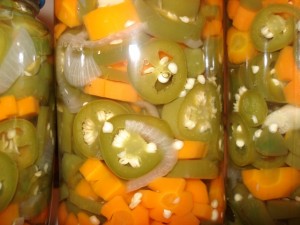
When it comes to Mexican food and it’s flavors, specifically heat, it seems like I’m always hearing salsa this and salsa that. Now, there’s nothing wrong with Salsa, it’s just that thanks to far too many stereotypes, & the lack of proper knowledge, the culinary art of salsa making has been devalued, reduce to a very mild, & oversimplified one cheap trick pony. In reality, when it comes to heat & spicy flavors in the Mexican kitchen, the realm of possibilities is so vast. Your options are so diverse, and varied that you can be at no loss when looking to turn up the taste in your dishes. With the right ingredients you can arm yourself with the ability to produce: unique, extraordinary, and super flavorful surprises. What sort of ingredients? Well, Take for example today’s spotlight food: “Chiles en Vinagre” = Chilies in Vinegar, pronounced (Chee -lehs- ehn -Bee-nah- greh). Chiles en vinagre are pickled peppers. Some use Serranos in their recipe, others use Jalapeños. The basic Chiles en Vinagre recipe actually calls for the pickling of green chilies,carrots,and onions. There are those that will add other things such as cauliflower for example, but I’m more familiar & used to the basic recipe.
So salsa gets all too often automatically associated with Mexican food, to the point that it leads to a constrained singularization. Though this is one of the first things to be mentioned when talking of Mexican cuisine,the fact is that to some, Chiles en Vinagre are far more important. In some cases truly indispensable. There are people who claim they can not eat a proper meal without their chiles. To some this condiment is as important as salt & pepper. Week after week this is something on my grocery list. In my house, on our dinner table there’s always been a bowl of “chiles en vinagre” present.
The spicy treat is a great addition to all kinds of food. You can sprinkle the pickled juice on almost anything, you can munch on a crunchy carrot, or bite on a spicy, juicy pepper while you enjoy your meal. You can have “Chiles en Viangre” with : beans, eggs, on a torta(sandwhich),with tacos, along with stews, heck even with burgers or pizza… seriously the list goes on & on. With these chilies you can add spice to an already flavorful dish or you can spruce up a simple & humble meal. The latter is the key that is at the heart of true Mexican home cooking.
Find Chiles en vinagre in your local supermarket in the international foods isle, hispanic products isle, visit your local Hispanic Super Market, or
find them online at :
http://www.mexgrocer.com/catagories-chile-peppers-sliced-jalapenos.html
http://www.mymexicanpantry.com/chili-powders.html









